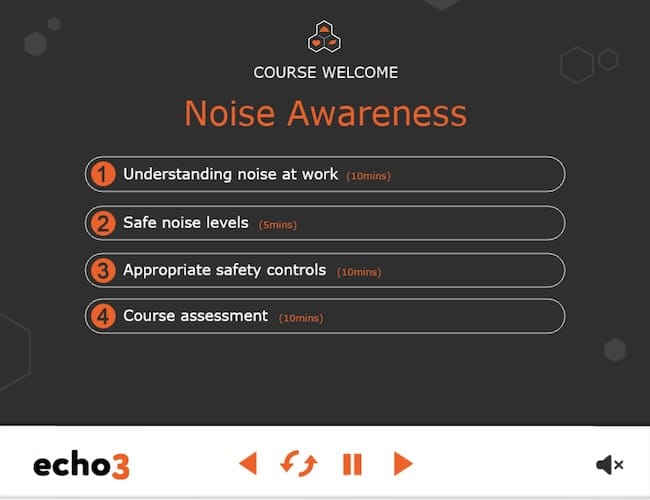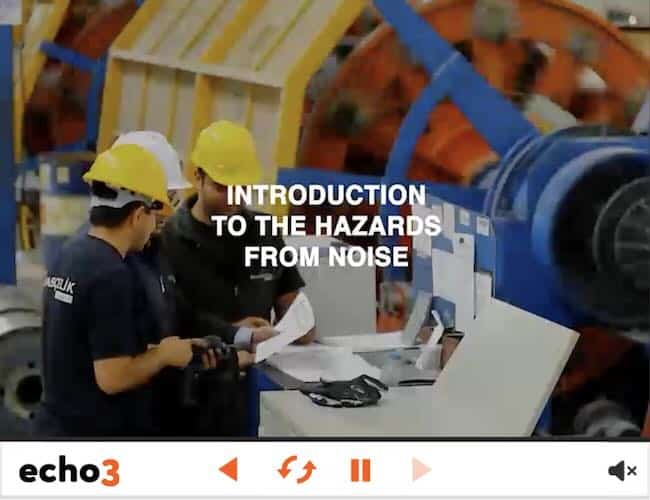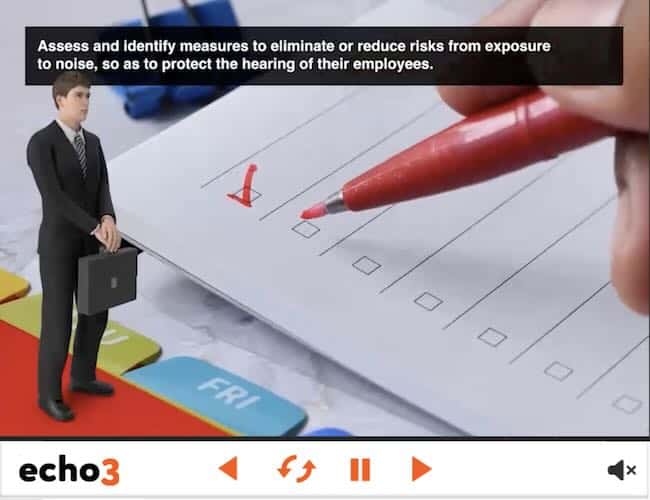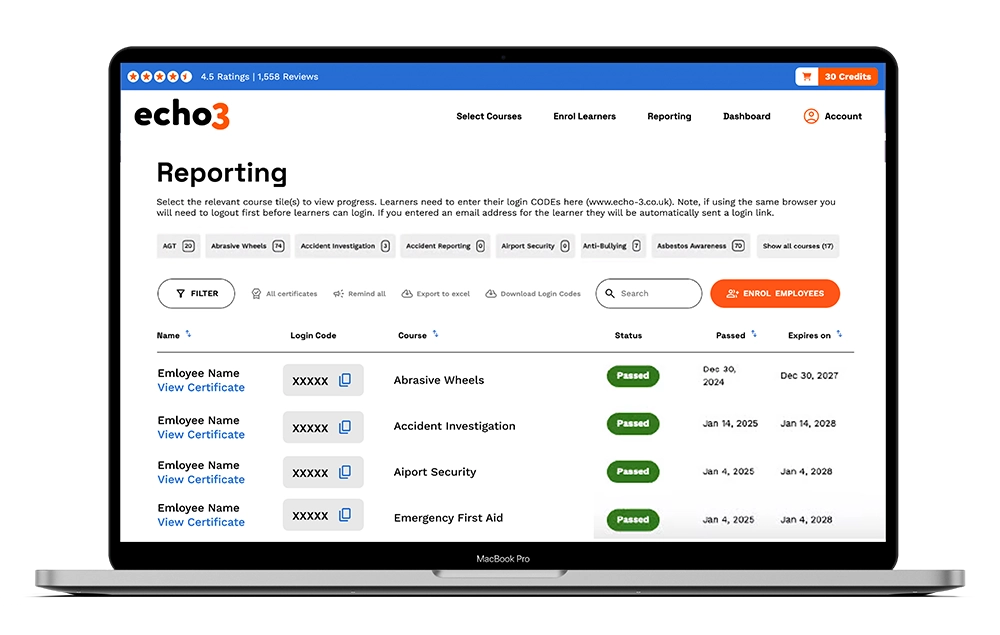Noise Awareness Course
All working environments are exposed to some level of noise. When employees are exposed to a daily or weekly average of 80 decibels employers have legal duties to control the risk.
Excessive noise at work causes thousands of people to suffer from deafness, ringing in the ear or other ear conditions. It can also lead to dangerous miss-communication.
It is often employees working in industrial environments that are most at risk due to the presence of machinery.
Keep in mind, once your hearing has been damaged it cannot be repaired. It will only become worse over time.
To protect staff, The Control of Noise at Work Regulations came into force in Great Britain on the 6th of April 2006.
To comply, one duty is for employers to provide appropriate training to staff.
This Noise Awareness course takes 30 minutes to complete. It provides employees with the knowledge needed to work safely where excessive noise exists.
Noise Course Content
UNIT 1 | Understanding Noise at work
In this first unit we introduce the hazards associated with noise at work. We also detail regulations and employee and employer responsibilities under Noise regulations.
UNIT 2 | Safe Noise Levels
In unit 2 we detail the various noise exposure action levels. These are the average and maximum levels where control measures must be adopted. We also state how staff can estimate if noise levels are safe.
UNIT 3 | Appropriate Safety Controls
In the 3rd and final unit, we outline various control measures and their hierarchy. How to determine appropriate control measures through a noise assessment. We also detail the purpose of health surveillance and various PPE options such as Ear Defenders & Ear Plugs.
Noise Awareness Course Certificate

Download and Print Your Certificate
- Written in compliance with the Control of Noise at Work Regulations 2005
- Developed by qualified health and safety professionals
- Accredited by CPD – learn more about CPD here
- Last Updated June 2025
- To gain the certificate you must complete the assessment which involves 20 questions.
- The online Noise Awareness certificate is valid for 3 years.
Course Preview
Echo3 courses include engaging motion-graphic video content, with full english subtitles
Reviews
How to Get Certified in 3 Steps
Individual Learners

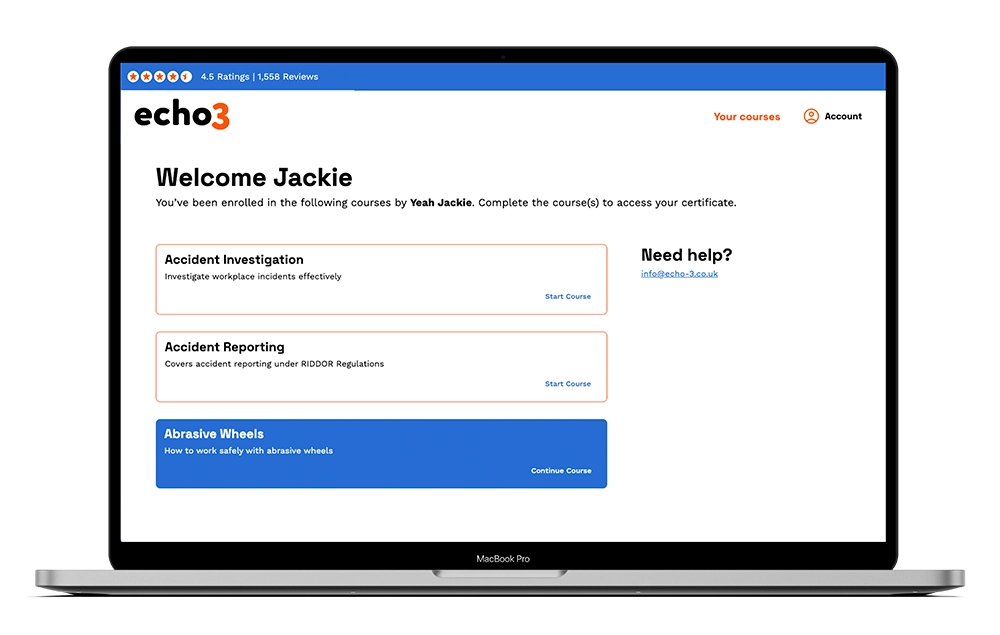
Benefits for Individuals
-
Engaging video-based content
-
Learner dashboard included
-
Instant access after payment
-
Free course retakes
-
Shareable digital certificate
 QR Code Certificate
QR Code Certificate




Bulk Buying Discounts
What are the Noise Awareness course learning outcomes?
By the end of this course, you should be able to:
- Identify the common noise hazards.
- Explain the Noise at Work Regulations.
- Identify the fragile component within the human ear and the different noise exposure warning signs.
- Identify the different recommended noise limits.
- Identify the risks of noise exposure.
- Describe the different noise control measures that can be used to keep yourself safe.
- And, Explain the different types of hearing protection available to you.
What are the warning signs of too much noise?
If you are exposed to too much noise you will likely get a few potential warning signs:
These include.
- Aheadache
- Ringing in the ears, and
- Dull hearing
If you notice any of these speak to your manager. You may need additional ear protection. Or your employer may need to redo the noise risk assessment and adapt how tasks are performed.
The hair cells in your ears are replenished during sleep and so usually these warning signs will go away. This depends on the original noise level and exposure duration. It can take one or more days to return to normal.
Act so these warning signs don’t reappear.
When does hearing damage typically occur?
The onset of hearing damage can occur when the sustained noise level reaches 85 decibels or more.
Most people will suffer some degree of deafness when they are exposed to Noise levels of 85 decibels and above for a sustained period.
UK Noise regulations set 2 thresholds where employers must act on noise.
80 decibels and above – If the daily or weekly average noise exposure level is 80 decibels or more, employers must undertake a noise risk assessment and provide staff with appropriate training or information. This is a requirement of noise regulations.
85 Decibels and above – When the average volume hits 85 decibels or more staff must wear appropriate ear protection.
This is also a requirement of noise regulations.
What are responsibilities for noise?
Employer responsibilities include
- Under the noise at Work regulations employers must also take the following actions.
- Appointing a competent person
- Assess and identify measures to eliminate or reduce risks from exposure to noise, so as to protect the hearing of their employees.
- Provide proper hearing protection for all employees.
- Ensure that any other controls are properly used, and
- Provide information, training and health surveillance.
Employees responsibilities include
- Use the safety control measures that have been provided and report any defects. For example, always use PPE that has been provided.
- Always use the hearing protection, provided.
- Attend any hearing checks provided by your employer.
- And, finally put into practice the lessons from training.
How is the ear affected by noise?
When sound enters the ear, it travels along the ear canal until it meets the ear drum, which then vibrates.
If very high sound pressures, hit the ear drum, it can cause a blast injury. Blast injuries can be caused by a nearby explosions or a physical blow to the ear.
The most common effects of a blast injury are short term hearing loss and tinnitus. Victims of a blast injury can also suffer a perforation of the ear drum membrane and permanent hearing loss.
In addition to blast injuries Hair Cell damage can also harm hearing. This is cause by prolong exposure to excessive noise.
With most sound pressures the vibration from the ear drum is passed onwards into the inner ear through three bones, arranged like a set of leavers to amplify the vibration.
After the vibrations from the inner ear bones, known as ossicles, are amplified they then pass to the cochlea, which is a fluid-filled, snail-shaped structure in the inner ear.
In the cochlea the vibrations in the fluid cause hair cells to vibrate and emit electrical impulses.
These electrical impulses are then sent to the brain by the auditory nerve. The brain interprets these electrical signals as what we hear.
The louder the sounds entering our ear canal, the more electrical impulses hair cells must generate.
Over time these hair cells lose their ability to generate electrical signals, and our hearing deteriorates. This hair cell deterioration is accelerated by loud noises.
This is because each time hair cells emit an electrical impulse; they use up a portion of stored energy. Think of the hair cells as rechargeable batteries, with loud noise they need to discharge at a faster rate. And just like batteries over a prolonged period, they become weaker.
So continued exposure to loud noises, needs to be avoided otherwise your hearing is likely to deteriorate faster.











